Watt's All the
Fuss?
by Bob Brooke
Early in the 1950s, my grandmother went to the grocery store and brought
home what she thought was a nifty premium—a coffee mug with an apple
painted on it. She loved coffee and her mug so much, she brought home
several more mugs, plus a spaghetti bowl, and a covered casserole dish
to hold the delicious pasta and meatballs and sausage she made every
Sunday. The items, made by the Watt Pottery of Crooksville, Ohio, that
she bought inexpensively at the grocery store back then are today worth
a small fortune.
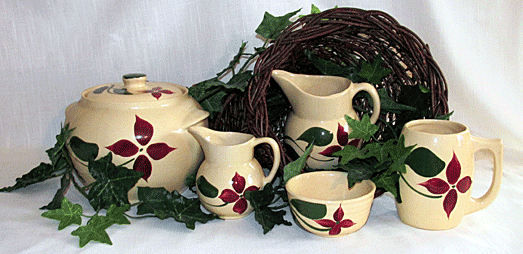
Watt's Early Years
The Watt family of Perry County, Ohio, opened the Watt Pottery in July,
1922 on the site of the old Burley Pottery in Crooksville. Through the
remainder of the 1920s and into the early 1930s they made stoneware
butter churns, crocks, jugs, and preserve jars, which they marked with
an acorn or an eagle stamped in blue, plus the number of gallons the
vessel would hold marked in a circle on the bottom.
But the introduction of oven ware pottery, enabling cooks to take a
container from their ice boxes and put it directly into their ovens,
forced the Watt pottery to discontinue its stoneware line and pursue the
more lucrative oven ware.
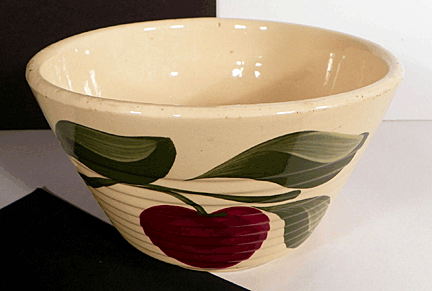 The
lightweight clay body, made of a percentage of feldspar and whiteners
which prevented the clay from discoloring after firing in the pottery
kilns, also made it resilient enough to withstand the extremes in
temperature. In addition, the whiteners gave Watt’s pottery its
brightness, especially when overpainted with brightly colored motifs
featuring apples, cherries, roosters, and flowers. However, Watt never
produced white clay pieces. The clay bodies of all Watt ware was always
a creamy color. The
lightweight clay body, made of a percentage of feldspar and whiteners
which prevented the clay from discoloring after firing in the pottery
kilns, also made it resilient enough to withstand the extremes in
temperature. In addition, the whiteners gave Watt’s pottery its
brightness, especially when overpainted with brightly colored motifs
featuring apples, cherries, roosters, and flowers. However, Watt never
produced white clay pieces. The clay bodies of all Watt ware was always
a creamy color.
By the late 1940s, the Watt Pottery began focusing on making kitchenware
glazed in solid colors in patterns named Arcs, Diamond, Grooves, Loops,
and Moon & Stars—all designated by collectors.
In 1949, the Watt Pottery began hand decorating its wares using simple
patterns in bright colors on an ochre-colored clay base. To minimize the
cost of producing these wares, teams of three decorators used as few
brush strokes as possible. The housewives of the 1950s loved the country
charm of these wares. And because they were so inexpensive to produce,
Watt wares began appearing a premiums in grocery and department stores.
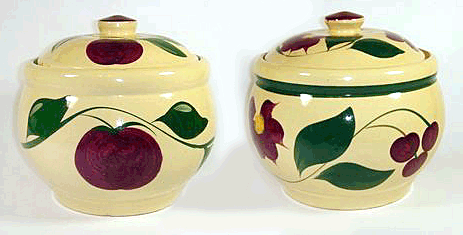
The first group of hand-decorated patterns, produced from 1949 to 1953
and considered the Classics, included the Cross-Hatch, Dogwood,
Moonflower, Rio Rosey, and the White Daisy. The pottery began producing
wares using a second set of patterns in the early 1950s, including the
Starflower (1951), Apple (1952), Cherry (1952), Silhouette (1953),
Rooster (1955), Dutch Tulip (1956), American Red Bud (Tear Drop) (1957),
Morning Glory (1958), Autumn Foliage (1959), Double Apple (1959), and
Tulip (1961). Of these, the Apple and Cherry patterns and their
variations, plus the Rooster, became the most popular.
Altogether, the Watt Pottery produced wares decorated in 16 patterns,
including four variations of the Apple Pattern, one in the Cherry
Pattern, two of the Tulip Pattern, six in various flower patterns, plus
Autumn Foliage and Eagle Patterns. The pottery remained in business
until a fire in 1965 destroyed the manufacturing plant and halted
production.
Identifying Watt Pottery
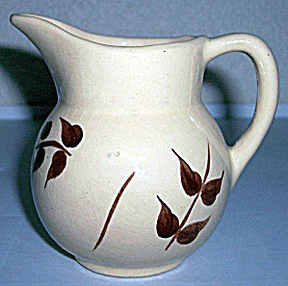 Generally,
Watt Pottery wares are easy to identify because of the unmistakable dark
cream color of the clay. In addition, the company clearly marked most of
its pieces. However, the earliest of its oven wares weren’t always
identified with the Watt Pottery mark. The kitchenware patterns of the
late 1940s, generally but not always included “MADE IN U.S.A.” and “Oven
Ware” marks impressed on the bottom of the piece, plus, in the case of
bowls, the size. Generally,
Watt Pottery wares are easy to identify because of the unmistakable dark
cream color of the clay. In addition, the company clearly marked most of
its pieces. However, the earliest of its oven wares weren’t always
identified with the Watt Pottery mark. The kitchenware patterns of the
late 1940s, generally but not always included “MADE IN U.S.A.” and “Oven
Ware” marks impressed on the bottom of the piece, plus, in the case of
bowls, the size.
By the late 1930s, the Watt Pottery Company began marking the bottom of
its ovenware. The company marked the words “Oven Ware-Made In USA”
inside the mold on most pieces. Various pieces from this time bear only
the size of the bowl, not the full mark. Watt couldn’t use the words
“Oven Ware” as a registered trademark because other companies made it,
also. But it appears on nearly all of the pieces of Watt Pottery from
the late 1930s until the end of production in 1965.
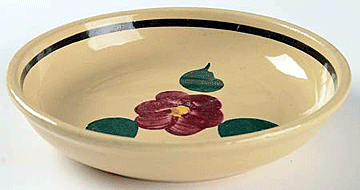 Although
the firm didn’t mark all of its pieces, workers impressed the bottom of
each piece of 1940s Watt ware with the words "MADE IN U.S.A." . Pieces
may also be marked "Oven Ware" or simply have the bowl size impressed.
Classic Watt Pottery patterns often feature a script “Watt” with no
circles. Most pieces also have the mold number impressed in the center,
making identification easy. Watt’s ice bucket in all patterns, salt and
pepper shakers, and its Apple dinner plates weren’t marked. Since Watt’s
markings varied over the years, it’s sometimes difficult to date pieces
by their bottom marks. Because the Watt Pottery Company produced many
lines of pottery for other companies, these pieces in many cases will
either bear the other company’s name or a product line on the bottom. Although
the firm didn’t mark all of its pieces, workers impressed the bottom of
each piece of 1940s Watt ware with the words "MADE IN U.S.A." . Pieces
may also be marked "Oven Ware" or simply have the bowl size impressed.
Classic Watt Pottery patterns often feature a script “Watt” with no
circles. Most pieces also have the mold number impressed in the center,
making identification easy. Watt’s ice bucket in all patterns, salt and
pepper shakers, and its Apple dinner plates weren’t marked. Since Watt’s
markings varied over the years, it’s sometimes difficult to date pieces
by their bottom marks. Because the Watt Pottery Company produced many
lines of pottery for other companies, these pieces in many cases will
either bear the other company’s name or a product line on the bottom.
Current Market Value
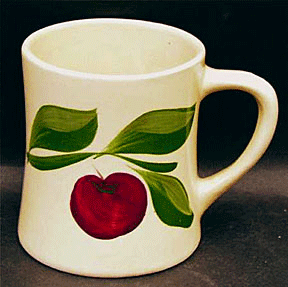 The
spaghetti bowl my grandmother purchased back in 1952 is now worth around
$95. The covered bowl she put her meatballs and sausage in now comes in
at $150. But the big surprise are the coffee cups. These full-size mugs,
which I took to college and drank coffee and Tang from, now are worth a
whopping $200 each. If I had only known. The
spaghetti bowl my grandmother purchased back in 1952 is now worth around
$95. The covered bowl she put her meatballs and sausage in now comes in
at $150. But the big surprise are the coffee cups. These full-size mugs,
which I took to college and drank coffee and Tang from, now are worth a
whopping $200 each. If I had only known.
The artists and potters of this family owned business took great pride
in their ability to produce many different hand decorated patterns. As
years pass us by, the rarity of this pottery becomes more prevalent in
the investment of the collecting. Many items still exist today but the
pottery is relatively scarce and continues to increase in value. Certain
pieces in many patterns are very hard to come by in this day in age.
To read
more of my articles, please
visit
my Web site.
< Back
to Collectibles Archives
Next Article
>
|
